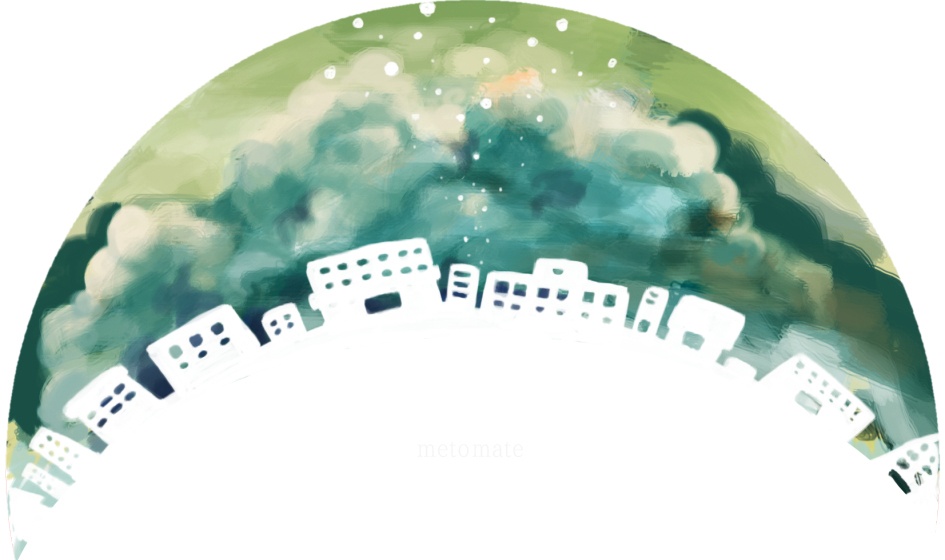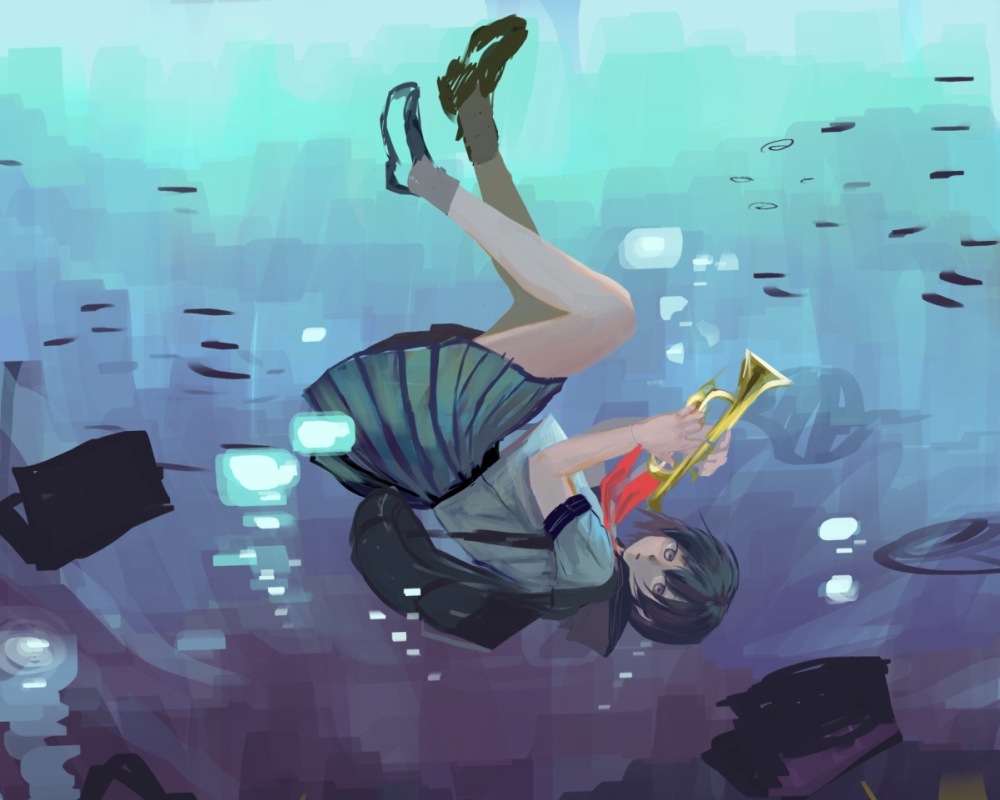Liner notes
TL note: This section is a translation of the freely available Fanbox post describing this album's concept.
This is a chat about the concept and production of the album “Yumemiru Shoujo to Nanatsu no Shuumatsu”, the new release for M3-44 in Fall 2019. Like I mentioned in the last album concept post (translated here), this is definitely not the “correct” interpretation of the album! Really, if I had to say, I myself am more of a “the listener's interpretation is that song's interpretation” kind of person. So I would be glad if you would take the details presented here loosely!
The Dreaming Girl and the Seven Endings
XFD on YouTube
The album I am presenting here, “Yumemiru Shoujo to Nanatsu no Shuumatsu”, was released in the fall of 2019, but parts of it can be traced back to the album “Yumemiru Shoujo no Yottsu no Shuumatsu”, containing five songs and released in spring of 2016:

(This is the inside of the case as well as the cover for that album. It's been a long time, so please excuse the fact that I touched up the character to match the cover of “Nanatsu no Shuumatsu”.)

(This is the image printed on the CD. It has themes of “the self, dreaming of individuality” and “death of the identity”, but what I had in mind was more like a pleasant dream than painful emotions.)
As the songs contained in the two albums are almost the same, I will present the liner notes of the two albums at the same time. The differences between the two albums is that for the later one, the songs have been remixed and remastered, the vocals have been rerecorded, and some new songs have been added.
As I will be discussing below, the true concept of the albums is “seven”, but when I was producing “Yottsu”, I was not confident that I could produce an album with nine songs in just half a year, and there were also other things I was not confident about, so to be safe I reduced the number of songs from 7 to 4 and ended up producing “Yottsu no Shuumatsu”.
The catchphrases of the two albums also differ. For “Yottsu no Shuumatsu”, it is “I kill myself, and I become an adult”. On the other hand, for “Nanatsu no Shuumatsu”, it is “From below myself, I am looking up.” I will explain the reasons for this later on!
Album concept and themes
As some of you might have noticed before, for “Yumemiru Shoujo to Nanatsu no Shuumatsu”, the trumpet on the cover image as well as the words “Seven” and “Ending” in the album name are based on the motif of the seven trumpets from the New Testament's Book of Revelation. The song titles also sometimes refer to this motif, as they are based on the causes of death that arrive in them. In Japanese I would have titled the songs like “Shoushi” (Death by Fire), “Dekishi” (Death by Drowning), or “Chuudokushi” (Death by Poisoning), but I felt it would have been too direct and disturbing, so I decided to give all of the songs English titles. (Although it might be all the more disturbing for English speakers...)
These themes do not have much relevance for the contents of the lyrics themselves: like with “Imashime to Juuichibanme no Aquarium”, the individual songs don't have a direct connection to the story.
What I wanted to depict in this album is the ending of “myself as a child”, and the human growth process of “becoming an adult while suppressing the self”, with the awareness of being observed by other people's “objective view of myself”.
The idea that the “self as a child” is something that must be suppressed, but is also something important and something that is required to be oneself — the idea that becoming an adult means suppressing the self — is the idea that is reflected in the catchphrase of the previous album “Yottsu no Shuumatsu”: “I kill myself and I become an adult.”
For each song, the hypothesis of “the character = the story” is incorrect, but each of the stories is read and empathised by the same girl, and I imagined that she then sinks each of those emotions to the bottom of her deep ego in self-admonition.
The meanings of the catchphrase “From below myself, I am looking up.” include things like, the ego that was sunk down to the bottom — the ego that was killed or suppressed — still looking at you full of regrets, and the childhood self wondering about what circumstances the grown-up self is in.
For “Yumemiru Shoujo no Yottsu no Shuumatsu”, I had the death (the Ending) of the dreaming girl herself in mind. For “Yumemiru Shoujo to Nanatsu no Shuumatsu”, I instead had in mind the dreaming girl learning about various stories, and in the process dying (that is, growing) by means of knowledge rather than experience. This distinction is also reflected in the different titles: “Shoujo no” (“The Dreaming Girl's”) versus “Shoujo to” (“The Dreaming Girl and...”)
The motivation to create this album
Recently, I mentioned that I wanted to stop producing albums for the time being, so I could focus on doing what I wanted to do. I was feeling similarly at the time when I was producing this album: I just wanted to turn into reality what was inside my head, without paying attention to what others thought of it. So I stopped participating in M3's “fantasy” slot and instead applied for their rock space for the first time.
I had the desire to remake the album because it was first produced at a time when my production ability and circumstances were not as good as they are now, and my strong emotional attachment to the album made me want to remake it with my now improved home recording and mixing capabilities, which will most likely not change a lot in the future. Also, during the time when I released “Yottsu”, I had negative thoughts like “who would ever want to listen to 9 songs that I produced and sang myself”. (This was also a reason why I reduced the number to 5 songs). And because there were people who said “I like it!”, I became able to really start doing what I wanted to do. I'm truly thankful...
Album cover

The person in the middle is a character in the position of a trumpet player (like in the motif), a messenger of God, an angel; and in a wider sense, somebody who became an adult after being chosen by God. As the content of the music is not directly taken from the motif, I made a student play the trumpet instead. This is the second cover image I made right away for “Yottsu no Shuumatsu”, and to a certain extent I had already decided that I wouldn't be rejecting it.
This is the other cover that I made slightly before, and which I was going to put upside down:

I rejected it because I wanted the trumpet to be at the top of the image.
Changes during the production
There were no big changes in the production environment, however my tastes in mixing changed slightly from “Higan no Arcadia”.
To mention one thing that changed, for this album, I had a strong feeling of making the music sound exactly like I wanted. So I remember doing a lot of trial and error to get closer to what I like, for example by trying out three different kinds of drums both on their own and mixed together, for various different effects.
Even though I changed the drum sound for my most recent album, when I listen and compare them now, the drums from “Yumemiru Shoujo to Nanatsu no Shuumatsu” are heavier and have a more impressive presence. I think this is just right for this album, which has a lot of dark-sounding piano rock.
The end
Occasionally, people tell me that this album is their favourite album, which makes me happy, and at the same time gives me a feeling of closeness to them, which I embrace :)
Nevertheless, there might also be people who liked the songs, but who ended up feeling sad because of them. I'm sorry about that.